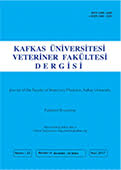
This journal is licensed under a Creative Commons Attribution-NonCommercial 4.0 International License
Kafkas Üniversitesi Veteriner Fakültesi Dergisi
2017 , Vol 23 , Issue 6
The Effects of Diets with Different Protein Contents on Growth Performance and Digestibility, and on Some Ruminal Fermentation and Blood Parameters, in Bafra Lambs
1Department of Animal Nutrition and Nutrition Diseases, Faculty of Veterinary Medicine, Ondokuz Mayıs University, TR-55139 Samsun - TURKEY2Department of Pharmacology and Toxicology, Faculty of Veterinary Medicine, Ondokuz Mayıs University, TR-55139 Samsun - TURKEY DOI : 10.9775/kvfd.2017.18007 The objectives of this study were to determine the effects of diet with increasing dietary levels of crude protein (CP) on digestibility, rumen pH, growth performance, volatile fatty acids (VFAs) and ammonia nitrogen (NH3-N), and on several blood parameters (serum urea, glucose and total protein), in the finishing period of Bafra lambs. Thirty male Bafra lambs, which were 3-3.5 months of age and average live weight of 24±0.4 kg, were divided into three groups (n=10 lambs per group) in a completely randomized design experiment. The diets were composed of 80% compound feed containing 11, 14 or 17% CP and 20% vetch straw. Lambs were fed ad libitium twice each day during the feeding trial period of 60 days. In the last week of the feeding period, all feces were collected to determine digestibility. The rumen and blood samples were collected at the end of the feeding period. The average feed intake was similiar among all tested diets. The best feed conversion rate was recorded the 17% CP diet. Final live weight and average daily gain (ADG) of lambs were significantly higher in lambs fed the 17% CP diet (P<0.05). CP digestibility was highest in the 17% CP diet (P<0.05) but the dry matter (DM) and organic matter (OM) digestibility were not affected by protein level. The rumen fluid NH3-N level increased significantly (P<0.05), pH and butyric acid level were not significantly affected, ruminal acetic acid and acetate:propionate ratio increased significantly (P<0.05) and propionic acid level decreased significantly (P<0.05) with the increase in dietary CP level. No significant differences were observed between groups for serum glucose and albumin, while the serum urea levels in the 14% and 17% CP groups were higher than for 11% CP (P<0.05). The highest economic value was for the 17% CP at 187.97%. Bafra lambs fed a diet containing 17% CP and vetch straw achieved a significantly higher body weight, had the best FCR and yielded a higher net profit than the other groups. If larger scale, on-farm studies confirm the findings of this study, Bafra lamb producers should be encouraged to maximise potential net profit by adopting its feeding regime, including 17% CP. Keywords : Bafra lambs, Crude protein level, Performance, Digestibility, Rumen fermentation, Blood parameters










